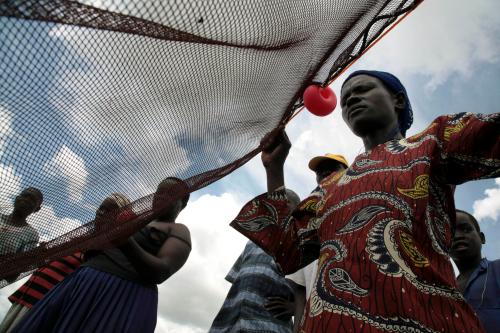Below is a viewpoint from the Foresight Africa 2022 report, which explores top priorities for the region in the coming year. Read the full chapter on African women and girls.
 Despite the progress women in Africa have made in the professional sphere, they remain underrepresented in strategic and essential positions. In fact, in academia, the representation of women can be likened to a pyramid where very few women exist at the top and in key leadership positions, especially in Africa. Moreover, only six out of the 26 higher education institutions in South Africa—a country that houses many of Africa’s top universities—are led by women. In Ghana, only 8 percent of professors from public universities are women. More broadly, across sub-Saharan Africa, women constitute only 24 percent of academic staff and 2.5 percent of vice chancellors. The African Education Research Database also indicates that, out of 2,510 African-led studies surveyed by the database, only 32 percent were led by women.
Despite the progress women in Africa have made in the professional sphere, they remain underrepresented in strategic and essential positions. In fact, in academia, the representation of women can be likened to a pyramid where very few women exist at the top and in key leadership positions, especially in Africa. Moreover, only six out of the 26 higher education institutions in South Africa—a country that houses many of Africa’s top universities—are led by women. In Ghana, only 8 percent of professors from public universities are women. More broadly, across sub-Saharan Africa, women constitute only 24 percent of academic staff and 2.5 percent of vice chancellors. The African Education Research Database also indicates that, out of 2,510 African-led studies surveyed by the database, only 32 percent were led by women.
Although institutional efforts to increase the representation of women in academia are increasing across the region, they tend to focus on increasing female enrollment in undergraduate studies rather than the hiring and retention of women in senior leadership positions. Obstacles such as structural barriers, traditional beliefs and norms, societal expectations, gender stereotypes, and the patriarchal nature of many African academic institutions make it challenging to make any significant progress. Moreover, the lack of female role models and mentors to guide young talented women through their academic careers exacerbates the gender gap: Female students are more likely to enroll in graduate studies when they encounter successful women role models.
Female students are more likely to enroll in graduate studies when they encounter successful women role models.
In addition, the few existing women pushing academic frontiers through their research and leadership in Africa are held to higher standards, constantly scrutinized, barely recognized, receive lower pay and poorer evaluations, and are recommended less than their male counterparts. They are also excluded from the gendered informal decision-making process, which usually occurs through informal networks. The demanding role of women in the caregiving economy and in childrearing, coupled with excessive administrative burdens, further delays career progression. Female faculty and students also face sexual harassment, or, at the very least, are too often judged by their physical appearance rather than their intellectual capabilities, which further dissuades them from staying in academia.
African universities must first commit, develop, popularize, and be intentional about institutional inclusive gender policies such as affirmative action, adaptable work environments accommodating childcare, and sexual harassment policies to advance female representation to break the glass ceiling. This strategy requires a well-articulated mechanism to track, monitor, and evaluate the implementation process. In addition, academic institutions should implement gender sensitization initiatives, which are vital in reducing tensions between female and male colleagues.
Policies to make the environment safer and more open to opportunities must start even before young, academically minded women enter the labor market.
Policies to make the environment safer and more open to opportunities must start even before young, academically minded women enter the labor market. Since the minimum requirement for most senior academic positions is a Ph.D., leaders must consider strategies to first increase the quantity and quality of women in post-graduate studies in Africa. Initiatives such as funding and research collaboration opportunities, institutional capacity to run doctoral programs, and efficient supervisory processes are crucial to executing this strategy.
Given that representation matters, mentorship programs tailored for junior academic ranks and led by senior female faculty offer a tremendous motivational tool in the quest to attract more women. In addition, identifying and building alliances with both women and men who are passionate about the advancement of women is another way to avoid isolation and combat hostility. Finally, women should be offered equal pay as men, including all fringe benefits, to prevent them from pursuing better-paying jobs outside of academia. While implementing these strategies, university leaderships should facilitate the documentation and collection of gender-disaggregated data to help assess progress.
The Brookings Institution is committed to quality, independence, and impact.
We are supported by a diverse array of funders. In line with our values and policies, each Brookings publication represents the sole views of its author(s).








Commentary
Strategies for advancing African women in academia
March 15, 2022